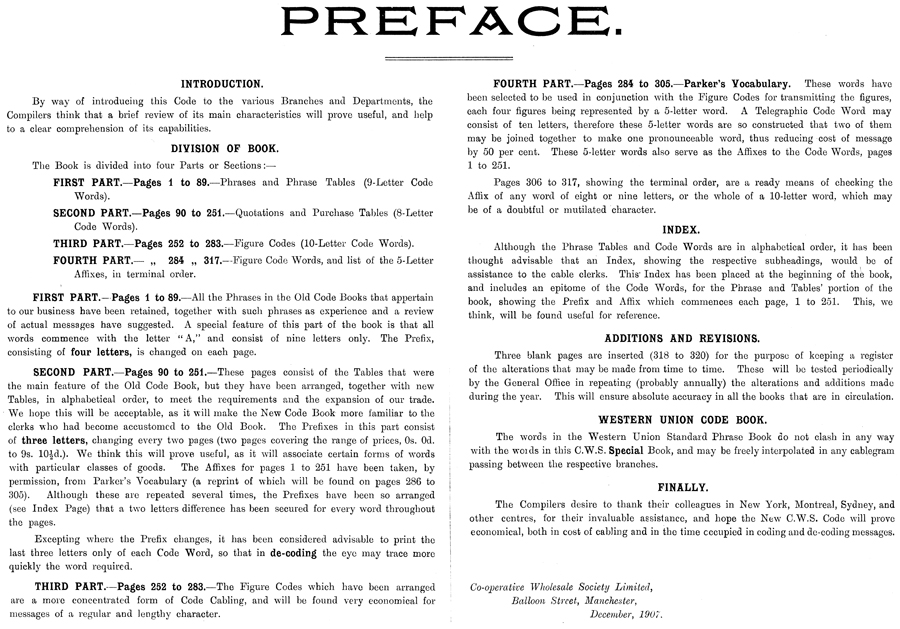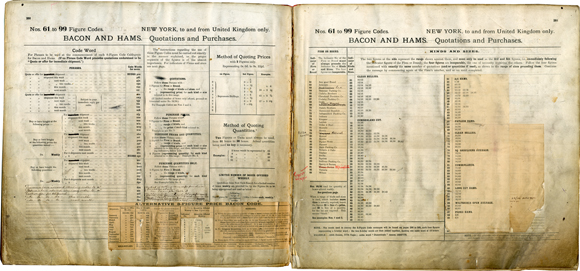
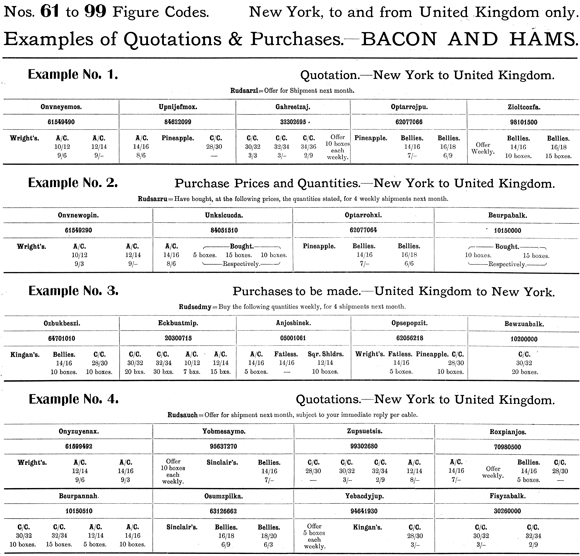
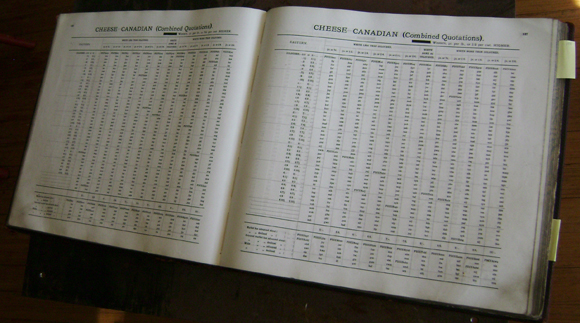
Quotations and market advices for cheese. A quotation expressed in one eight-letter code word give two prices, for Coloured and then for White at a certain amount less or more than for Coloured. Code pp 136-37.
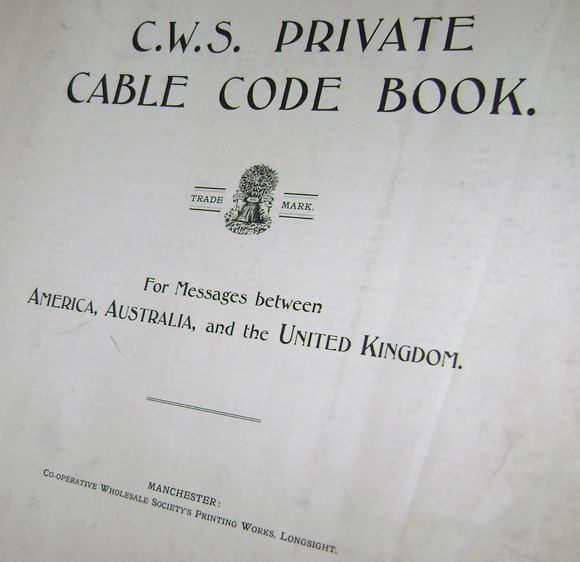
See Redfern for some treatment of the Longsight Printing Works.
C. W. S. Private Cable Code Book
For Messages between America, Australia, and the United Kingdom.
Manchester: Co-operative Wholesale Society’s Printing Work. Longsight. 1907
15h x 16w inches; [8]; 1-320.
private collection
Shown at left —
Above, pp 260-61 Nos. 61 to 99 Figure Codes : New York, to and from United Kingdom only. Bacon and Hams.—Quotations and Purchases.
Below, detail p 262, showing examples of same.
See also magnification of page 253 (which includes the Index to Figures Codes 01 through 99).
The code is arranged in four major parts —
- First Part (pp1-89) —
Phrases and Phrase Tables (9-Letter Code Words). -
Second Part (pp90-251) —
Quotations and Purchase Tables (8-Letter Code Words). -
Third Part (pp252-284) —
Figure Codes (10-Letter Code Words). -
Fourth Part (pp-284 to 317) —
Figure Code Words, and list of the 5-Letter Affixes, in terminal order.
Shown at left is but one section from Part III. This is the most soiled and intensely annotated/amended spread in this copy, indicating intensive use over several years. As the Preface explains, The Figure Codes which have been arranged are a more concentrated form of Code Cabling, and will be found very economical for messages of a regular and lengthy character.
Imports of bacon and hams from North America were, it would seem, a large business.
Here, one starts with a Code Word, e.g., RUDSAtgy / Quote or offer for shipment next week, subject to your immediate reply per cable. One proceeds to assemble the remainder of the message — that will concern Quotations, Purchase Prices, Purchase Prices and Quantities, or Purchase Quantities — by strictly building up by two-figure pairs for :
2 figures. Firm or Brand.
2 figures. Range of kinds (and possibly sizes).
2 figures. Representing price for each kind or size referred to in the range.
The basic unit is eight-figure units, that are later condensed to 10-L ciphers using a code vocabulary in the back of the book. (More exactly, each 4-digit figure converts to a 5-L pronounceable codeword, which can be combined with another to form a 10-L codeword acceptable to telegraph administrations.) Where a message, when complete, does not produce multiples of 8 figures, it is filled out with null ciphers.
The Preface
that is appended at bottom of this webpage, provides further details about this code and its working.
The Co-operative Wholesale Society
The Co-operative Wholesale Society seems to have originated in 1844 and still exists, much transformed and under a different name (The Co-operative Group). See —
- The National Co-operative Archive in Manchester;
- the group’s own history; and
- much more at wikipedia. See also
- Redfern, Percy. The Story of the C.W.S. : The Jubilee History of the Co-operative Wholesale Society Limited. 1863-1913. Manchester, etc., 1913(?)
Redfern does not mention cables specifically, but does implicitly in this extract from a C.W.S. Committee report of 1876, following establishment of an American office in New York —The importance of having opened the New York branch is daily experienced. We are thus enabled to ascertain the state of the market for cheese, bacon, lard, and grain, both there and in Liverpool, almost at the same time, and thus are enabled to determine when we can purchase with advantage.
(p97)
archive.org. - Kelley, Victoria.
The Equitable Consumer: Shopping at the Co-op in Manchester.
Journal of Design History 11:4 (1998) : 295-310
The article focuses on the complicated mix of ideas and ideologies that informed consumers’ purchase behavior, and the actions of the Co-op’s marketers and product designers. It does not get into those aspects of the business, like sourcing, in which cable codes played their role, but does suggest the scale and importance of C.W.S.
